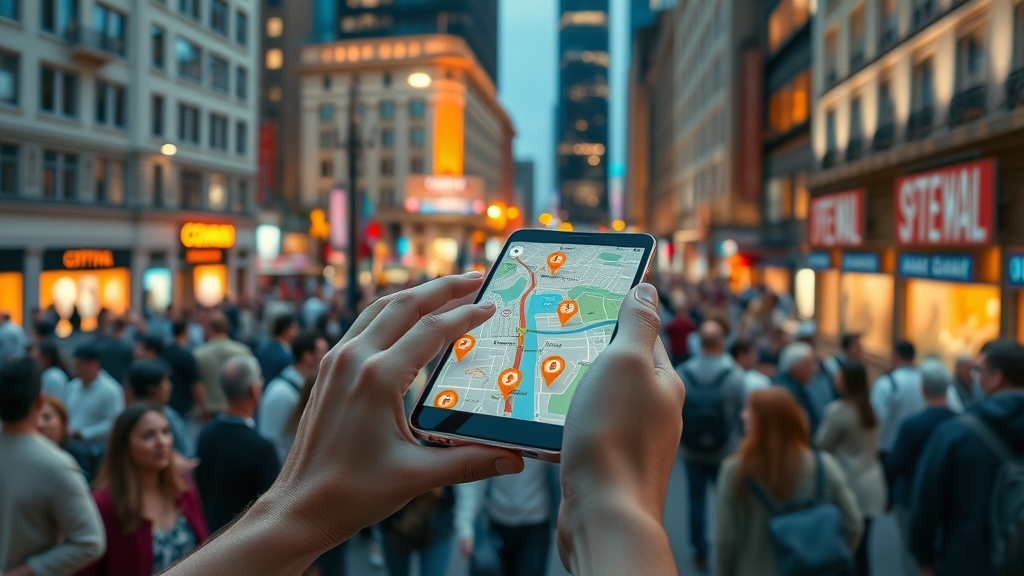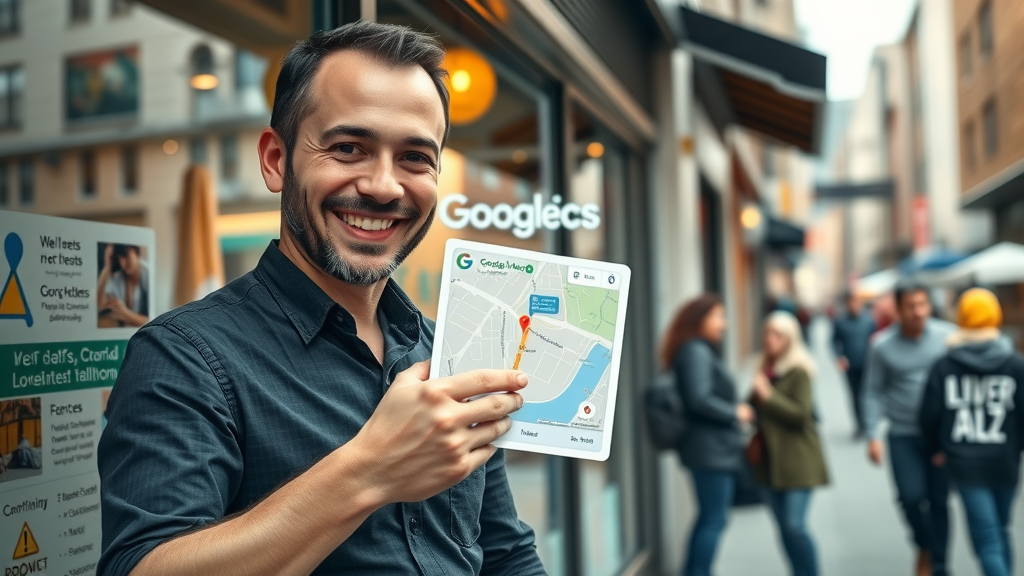Did you know that over 78% of local mobile searches result in an offline purchase? In today’s competitive market, simply existing online isn’t enough—dominating google local business optimization is your ticket to explosive sales growth this year. From ranking higher on Google Maps to leveraging powerful local search strategies, this comprehensive guide will arm your business with everything needed to convert online attention into real-world revenue. Read on to unlock step-by-step tactics and expert insights that can transform your bottom line.

Unveiling the Power of Google Local Business Optimization for Explosive Sales Growth
If your goal is to rank higher and attract more potential customers through local search, mastering google local business optimization is non-negotiable in 2024. The key to unlocking your business’s true sales potential lies in how well you manage and optimize your online presence—especially your google business profiles . Modern consumers use their phones to discover, evaluate, and choose which businesses to visit, so appearing in the top local results can mean the difference between obscurity and bustling sales.
Through this guide, you’ll understand not just the “what,” but the “how”—with tested strategies, real stories and advanced techniques to outpace the competition. Whether you’re setting up your first Google Business Profile or seeking advanced local SEO tricks, you’ll find the latest insights and practical checkpoints you need to dominate local search results .
- Why google local business optimization is crucial for modern brands
- Step-by-step strategies to rank higher in local search
- Ways to supercharge your google business profile
- Secrets to optimize your google my business profile
- Real-world case studies from local businesses
- Advanced google my business optimization techniques for 2024
Understanding Google Local Business Optimization: Concepts, Impact, and Key Factors
Defining Google Local Business Optimization and Its Benefits for Your Business
At its core, google local business optimization means refining and strengthening your digital footprint so your business consistently appears where local customers are searching. By updating information about your business, adding photos, and responding to reviews, your google business profile tells Google—and your audience—that you’re a relevant and reputable choice. The benefits are both immediate and long-lasting: better local rankings, greater trust, and significantly more foot traffic and calls from customers ready to buy.
Optimizing your google business profile doesn’t stop at basic details. Including accurate business hours, contact information, and showcasing your products and services keep your business ahead in local searches . Plus, a well-optimized profile can lead to engagement and conversions that outperform even the most expensive traditional advertising.

The Link Between Google My Business, Local Search, and Sales Performance
Your google my business profile is the linchpin of your local search strategy. Google uses the information you provide to match your business with potential customer queries, impacting whether you appear in the coveted “Local Pack”—the top three map listings on the search page. The more complete your information, and the more active you are (such as through regular updates or collecting reviews), the higher you’ll rank .
Local search isn’t just about visibility; it’s about sales performance . Businesses with robust, actively managed Google Listings see dramatic increases in location visits, calls, and website clicks. The synergy between an up-to-date profile and positive customer reviews directly fuels business growth. When your business information is consistent, accurate, and engaging, it creates a powerful feedback loop that moves you up the ranks and keeps you there.
"Businesses with complete and optimized Google Business Profiles are 70% more likely to attract location visits." – Google 2023 Report
Building and Optimizing Your Google Business Profile for Maximum Visibility
How to Set Up a High-Performing Google Business Profile from Scratch
Setting up your google business profile properly is foundational to google local business optimization . Start by claiming your business on Google and verifying your ownership through their process. From here, input your core business info : name, address, and phone number . Ensure all information exactly matches your website and other directory listings, as consistency boosts your credibility in the eyes of Google’s algorithms.
Next, provide as much detail as possible. Add rich descriptions, categories that accurately reflect your services, and upload high-quality photos showcasing your products, staff, and location. Optimizing your google my business profile also means setting business hours, enabling messaging, and actively updating posts to keep your business relevant. Remember: completeness and accuracy are king. Overlooking these steps can cause you to miss out on hundreds of potential customers every month.

Essential Elements: Business Information, Phone Number, Address, and Contact Information
To truly optimize your google profile, prioritize these critical areas: business information (name, address, phone), accurate business hours, and up-to-date contact information . Google and users both rely on this for trust and interaction, so any inconsistencies can undermine your ranking or customer experience.
Include not just your main phone number , but additional methods of contact if available. Double-check the spelling and format of your address, and make sure you select the right categories and attributes that describe your business. These details impact your visibility in relevant searches and ensure potential customers can get in touch seamlessly.
Enhancing Your Google My Business Profile to Boost Local Search Rankings
Beyond the basics, boosting your google my business profile for local search revolves around maximizing completeness and engagement. Regularly update your profile with posts about events, offers, or news. Respond to questions and answers from users, and ask happy customers for reviews. Google values active profiles—activity and freshness are factors that can help your business rank higher than less active competitors.
Uploading timely photos, optimizing product and service listings with location-based keywords, and maintaining a schedule of posts keeps your business profile dynamic and appealing. Don’t forget to monitor insights within your profile dashboard to see how users interact with your business info, tweaking your content to better meet their needs.
- Accurate business hours
- Verified phone number and address
- Service and product listings
- Professional business photos
- Clear business description
- Up-to-date posts and updates
| Element | Importance | How to Optimize |
|---|---|---|
| Business Info | Critical for search ranking and trust | Ensure complete, consistent, and verified details |
| Phone Number | Essential for customer outreach | Verify, update, and display prominently |
| Business Hours | Key for user experience and visibility | Accurately set hours and update seasonally or for holidays |
| Products and Services | Boosts relevancy in search results | Add clear descriptions, categories, and photos |
| Reviews | Drives trust and conversion | Request, respond to, and resolve reviews regularly |
Advanced Google Local Business Optimization Tactics: Stand Out in Local Search

Using Google Maps Integration to Boost Foot Traffic and Rank Higher
A top strategy for google local business optimization is syncing your business profile with google maps . When users look for a service or product near them, Google Maps is often their first stop. Ensuring that your business listing is not just present but optimized with rich photos, reviews, and regular updates can help your location rank higher in both Google Maps and local search.
Take extra care to position your map marker accurately and add details about nearby landmarks for clarity. Businesses that rank higher on Google Maps consistently report increases in foot traffic, as users follow map directions directly from their search. Optimize your products and services listings to include local keywords and keep your business hours up to date for best results.
Encouraging and Managing Reviews to Improve Google My Business Profile Performance
Customer reviews are a direct ranking factor for local search and a trust signal to everyone who views your google business profile . The more positive, detailed reviews you receive—and the more actively you respond to them—the stronger your profile becomes in the eyes of both Google and your community. Make it simple for customers to leave reviews by sending follow-up texts, emails, or using QR codes in-store.
Don’t avoid negative reviews: address them professionally and show concern for customer satisfaction. Showing responsiveness and genuine care tells Google—and future potential customers —that you run a business committed to excellence. Consistent engagement with reviews doesn’t just improve your ranking; it shapes your reputation in a digital-first world.

Leveraging Google Ads to Strengthen Your Local Business Exposure
While organic optimization is crucial, supplementing your local campaigns with google ads can help your business appear above even the top-ranked organic search results. With precise targeting, local ad extensions, and custom audience options, Google Ads enables you to reach customers when they’re ready to buy.
By integrating google ads with your business profile, you can feature your address, phone number, and map location directly in your ads, creating a seamless experience for users from the search page to your storefront. Tracking ad performance with Google Business Insights helps you refine your campaigns for even higher ROI—blending paid and organic efforts is often the secret sauce to dominating local visibility.
Utilizing Products and Services Listings to Optimize Your Google Business Presence
Harness the power of your google business profile by thoroughly listing your products and services with current descriptions and enticing photos. This not only improves keyword relevancy in local search but also empowers customers with the information they need to choose your business over the competition.
Refresh your offerings frequently and highlight seasonal promotions or featured items. Each update is a signal to Google that your business is active and relevant, contributing to higher placement in search results and potentially even earning you a coveted spot in the Map Pack for relevant searches.
How Consistent Contact Information and Business Hours Help Rank Higher
Google values consistency above all else for business information . Ensuring that your name, address, phone number (known as NAP), and business hours are identical across your website, Google profile, and other directories boosts your authority and ranking in local searches .
Inconsistencies in contact information or missed business hour updates can confuse both customers and Google’s algorithms, resulting in lower placement or even profile suspensions. Set reminders to review and update your details monthly, and always reflect changes in real time—especially during holidays or special events.
"Positive reviews and consistent updates are direct ranking factors for local search on Google." – Local SEO Industry Expert
Mastering Local Search: Strategies to Rank Higher and Outshine Competitors

Local SEO Best Practices Beyond the Google Business Profile
Dominating local search requires going beyond your own business listing . Implement site-wide local SEO techniques by adding location-based keywords to your website content, creating location-specific landing pages, and ensuring your site is mobile-friendly. Schema markup can give Google extra context about your business information , products, and services, improving your position in relevant searches.
Link-building from reputable local websites (like chambers of commerce, local news, or community events) broadens your digital presence and builds authority. Remember, Google’s local algorithms favor businesses that are both prominent online and trusted by the local community.
Harnessing Social Media and Citations to Strengthen Google Local Business Optimization
Strategic use of social media and citations are vital to optimize your google profile and overall online footprint. Consistently post updates, deals, and events on platforms like Facebook and Instagram, ensuring contact info and hours match your google business profile .
Building citations across trusted directories (like Yelp, TripAdvisor, or industry-specific platforms) reinforces your authority and provides additional pathways for potential customers to find your business. Each citation is a “vote” of credibility in Google’s algorithms, further cementing your place in local search results .
Tracking Performance: Analyze Your Google Business Insights and Metrics
To keep improving and maintaining your google local business optimization , consistently monitor performance. Google Business Insights provides valuable data about how users find your business listing , what actions they take (calls, website visits, direction requests), and which content performs best.
Analyze trends in activity around your business profile , such as the impact of new photos, responses to reviews, or posts about special offers. Use these insights to make data-driven decisions—doubling down on what works and experimenting with new tactics to outshine the competition.
Real-World Success Stories: Google Local Business Optimization in Action

Case Study 1: Local Restaurant Doubles Revenue After Optimizing Google My Business
A family-owned restaurant in a mid-sized city struggled to attract new diners, despite great reviews offline. By fully optimizing their google my business profile —adding vibrant photos, updating business hours, encouraging diners to leave reviews, and posting regular lunch specials—the restaurant leaped to the top of local search and Google Maps results. Within three months, website visits and phone calls shot up, leading to a remarkable twofold revenue increase and packed tables, even on weekdays.
Their experience underscores the power of consistent engagement, high-quality photos, and a strong reviews strategy. The once-quiet lunch rush became their busiest hour, all thanks to a dedicated focus on google local business optimization .
Case Study 2: Service Business Ranks Higher and Outpaces Local Competitors

An HVAC contractor faced fierce competition from larger chains but used optimizing your google business profile to level the playing field. By ensuring precise contact information , publishing weekly posts, and responding to every customer review—positive or negative—they saw a 35% increase in calls from their google business profile .
Leveraging products and services categories and running geo-targeted google ads gave them a further edge. Soon, their business regularly ranked above competitors in local search and captured leads that previously went elsewhere.
Analysis: Key Takeaways from Optimizing Your Google Business Profile
Real-world results consistently show that businesses prioritizing their google business profile —with up-to-date info, responsive reviews, compelling images, and active posts—see the strongest gains. Whether you’re a restaurant, service provider, retail shop, or clinic, these tactics not only improve your search ranking but also build loyalty and trust, making your business a go-to choice in the local marketplace.
The path to success is clear: consistently optimize , actively engage, and leverage every feature Google provides. Businesses that make this a habit continue to reap compounding results year over year.
Answering Top Queries on Google Local Business Optimization

How to boost local ranking in Google for business?
To boost your local ranking on Google, complete every field in your google business profile . Ensure your business information is consistent across your website, Google, and online directories. Promptly respond to reviews, keep your profile updated with fresh posts, and upload recent business photos. Don’t forget to match your business categories precisely to your main service. All these steps combine to improve your visibility in local search and attract more potential customers .
Actionable Tactics:
- Complete every field in your Google Business Profile
- Consistent NAP (Name, Address, Phone) online
- Collect reviews and respond to them
- Post regular updates and offers
- Ensure business categories match your service
What is Google My Business Optimization?
Google My Business optimization is the ongoing process of updating, verifying, and improving every aspect of your profile to maximize your visibility and engagement in Google’s local search results. This includes accurate business hours, a verified phone number , complete descriptions, good images, timely posts, and gathering customer reviews. The goal is to position your company as the most appealing and visible business for anyone searching locally for your product or service.
Google My Business optimization means updating, verifying, and improving every aspect of your business profile to maximize visibility and engagement in local search.
Each update, review response, and photo upload signals to Google that your business is active and trustworthy. Businesses that invest in this process enjoy more search results visibility, more clicks, and higher conversion rates from online searches to real-world visits.
Is SEO worth it for local businesses?
Absolutely. Local SEO —including google local business optimization —offers an unmatched return by delivering consistent quality leads, building local trust, and driving foot traffic in a way that traditional advertising methods simply can’t match. It’s not just worth it; it’s essential for modern growth.
What is local business optimization?
Local business optimization is the process of enhancing your online presence—including optimizing your google business profile —to increase visibility and rank higher in local search results. It covers everything from accurate contact information and reviews to social and website updates, ensuring your business is always top-of-mind and easy to find.
Frequently Asked Questions about Google Local Business Optimization

How often should you update your google business profile?
Aim to review and update your google business profile at least once a month, or whenever changes occur—such as new hours, products, or special events. Frequent updates signal activity to Google, improve your ranking in search, and ensure customers always have accurate business information .
What kind of photos should you add to your business profile?
Add clear, high-quality images of your storefront, interior, team members, and best-selling products and services . Professional photos that showcase your environment and expertise create a positive impression, encourage more clicks, and help you stand out in local search .
How do you manage negative reviews on google my business?
Respond to all negative reviews promptly and professionally. Acknowledge the issue, apologize where appropriate, and offer a solution. This public engagement builds trust with both the reviewer and other potential customers reading your profile and can often turn critics into repeat visitors.
Can you optimize for multiple locations with one google my business account?
Yes! You can manage and optimize your google business profiles for multiple locations from one Google account dashboard. Make sure each location has accurate, unique profiles with specific business info and localized content to maximize local search performance city by city.
Key Strategies for Lasting Success in Google Local Business Optimization
- Keep your business profiles current
- Post consistently to Google My Business
- Monitor analytics and insights monthly
- Invest in both organic and paid local tactics
- Respond quickly to reviews and questions
Take Action Today: Transform Your Business Through Google Local Business Optimization
Start your optimization journey now: update your business profile, engage with customers online, and monitor your results. Google local business optimization is your path to more sales, loyal customers, and growth in 2024.
 Add Row
Add Row  Add
Add 




Write A Comment